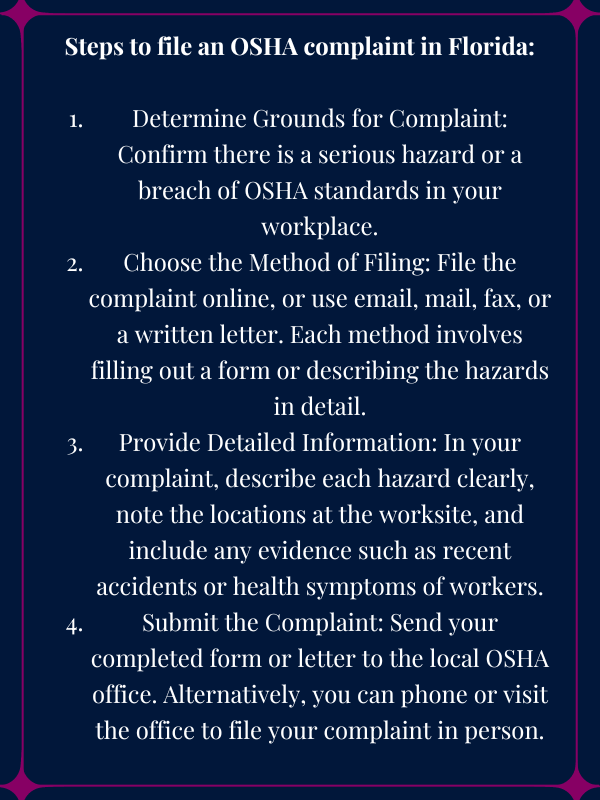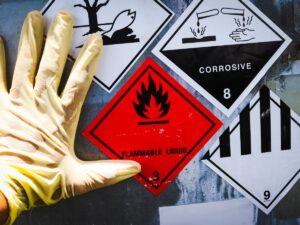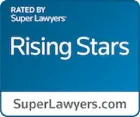Navigating Workplace Safety Complaints with OSHA in Florida

The Occupational Safety and Health Act of 1970 (OSH) requires employers to provide a safe workplace free from hazards that could result in death or serious physical harm to their employees. Employees also have the right to file complaints about safety hazards, ask inspectors to visit the job site, and make reports without fear of retaliation.
The OSH Act also created the Occupational Safety and Health Administration (OSHA), which sets and enforces safety regulations in the workplace. If your employer takes adverse action against you for filing an OSHA complaint, you can pursue legal relief from your employer. This is known as a whistleblower claim, or a lawsuit on behalf of the government and yourself.
In Florida, a Tallahassee workplace whistleblower lawyer from Cruz Law Firm, P.A., can help you if you are considering reporting your employer to OSHA or have experienced retaliation after filing an OSHA complaint. We can help you seek compensation for losses you suffered due to retaliatory employment decisions, such as denial of promotions or raises, adverse reassignments, or firing.
Contact our law firm today for a confidential consultation about whistleblower protection laws and how we can help you.
Understanding Florida’s Workplace Safety Framework
Many OSHA standards require employers to train employees to ensure they have the skills and knowledge to do their work safely. OSHA also provides training and other programs to help employers meet standards.
OSHA’s enforcement authority includes inspecting workplaces and penalizing employers who violate standards. Penalties include abatement orders (orders to stop specific acts) and monetary fines.
Florida OSHA regulations apply to most private-sector workers within the state. Federal OSHA rules do not cover state and local government workers.
How to File a Workplace Safety and Health Complaint with OSHA

A Florida employee or their representative (such as a workplace whistleblower attorney) has the right to file a confidential safety and health complaint and request an OSHA inspection of their workplace if they believe there is a serious hazard or their employer is not following OSHA standards. Workers also have the right to report actions taken against them for speaking or file both types of complaints if appropriate.
There are several ways to file a Florida OSHA complaint. You can complete an online complaint form. Fill out the form as accurately and thoroughly as possible. Describe each hazard you think exists in as much detail as possible. If the safety and health hazards are all in different areas, identify their location at the worksite. If any particular evidence supports your suspicion (e.g., a recent accident or physical symptoms of employees at your site), include the information in your description.
A different but similar form exists for complaints by email, mail, or fax, or you may write and send a letter describing your complaint. Send the form to your local OSHA office, which you may also telephone or visit to file a complaint.
Role of Occupational Safety and Health Administration (OSHA) in Florida
The OSH Act requires employers to try to eliminate or reduce workplace hazards by making feasible changes in working conditions, such as switching to safer chemicals or processes that trap harmful fumes, rather than merely relying on personal protective equipment, like masks or gloves.
Employers must also:
- Inform workers about hazards through training, labels, alarms, color-coded systems, safety programs, fact sheets, and other methods
- Train workers in a language and vocabulary they can understand
- Prominently display an official OSHA poster that describes its rights and responsibilities
- Keep accurate records of work-related injuries and illnesses
- Perform tests in the workplace, such as air sampling, as required
- Provide hearing exams or other medical tests as necessary
- Post injury and illness data and OSHA citations in a visible location
- Notify OSHA within eight hours of a workplace fatality
- Inform OSHA within 24 hours of any work-related inpatient hospitalization, amputation, or loss of an eye
- Not retaliate against workers for exercising their legal rights, including reporting a work-related injury or illness
OSHA conducts worksite inspections to enforce OSH Act provisions that protect workers and their rights. Trained compliance officers conduct inspections based on the following priorities:
- Imminent danger
- A fatality or hospitalization
- Worker complaints and referrals
- Targeted inspections related to particular hazards with high injury rates
- Follow-up inspections
OSHA initiates inspections without advance notice, regardless of whether the inspection is in response to a complaint or is a programmed inspection.
Legal Rights and Safety Protections for Employees
A worker employed by an employer falling under OSHA’s jurisdiction has the right to:
- Work under safe conditions that do not pose a serious threat to the worker’s well-being, including:
- Working on safe machines
- Being protected from toxic chemicals
- Receiving required personal protective equipment (PPE) as needed
- Report unsafe conditions to the employer about workplace dangers without fear of retaliation or discrimination
- File a confidential safety and health complaint
- Request and participate in an OSHA inspection and speak privately with the inspector
- Receive information and training about hazards, safety methods, and applicable OSHA standards in a language and vocabulary the worker understands
- Review records of work-related injuries and illnesses
- Receive copies of the results from tests and monitoring done to measure hazards in the workplace
- Report injuries or illnesses and get copies of their workplace medical records
- File a complaint if the employee has been retaliated against for making a complaint
- Refuse hazardous work if:
- The worker asked the employer to eliminate the danger, and the employer failed to do so.
- The employee refused to work in good faith.
- A reasonable person would agree there is a real danger of death or serious injury.
- Due to the urgency of the hazard, there is insufficient time to mitigate the danger through regular enforcement channels, such as requesting an OSHA inspection.
Common Workplace Hazards and Prevention Strategies

OSHA has specific standards for reducing potential workplace threats and other safety issues, including:
- Fall prevention. Employers must set up the workplace to prevent employees from falling from overhead platforms, elevated workstations, or holes in floors and walls. Fall protection is required at elevations of four feet in general industry workplaces, five feet in shipyards, six feet in the construction industry, and eight feet in longshoring operations. OSHA also requires fall protection when working over dangerous equipment and machinery, regardless of the fall distance.
- Hazardous chemicals. Information about the identities and hazards of chemicals must be available and understandable to workers. All employers with hazardous chemicals in their workplaces must have labels and safety data sheets for exposed workers and train them to handle the materials appropriately.
- Respiratory protection. Employers must identify and evaluate the respiratory hazard(s) in their workplaces. Various types of Occupational Exposure Limits (OELs) have been established by a number of industries. Respirators protect workers against insufficient oxygen environments, harmful dusts, fogs, smokes, mists, gases, vapors, and sprays. These hazards may cause cancer, lung impairment, diseases, or death.
- Dangerous machines. Moving machine parts have the potential to cause severe workplace injuries, such as crushed fingers or hands, amputations, burns, or blindness. Guards are essential for protecting workers from these preventable injuries. Machine guarding hazards are addressed in specific OSHA standards for agriculture, general industry, maritime, and construction.
- Confined spaces. A confined space is not necessarily designed for people but is large enough for workers to enter and perform certain jobs. Examples include tanks, vessels, silos, storage bins, hoppers, vaults, pits, manholes, tunnels, equipment housings, ductwork, and pipelines. These areas have characteristics that could endanger a worker through exposure to dangerous materials, collapses, unguarded machinery, live wires, or heat stress.
- Hazardous energy control (lockout/tagout). Energy sources, including electrical, mechanical, hydraulic, pneumatic, chemical, thermal, or other sources in machines and equipment can be hazardous to workers. During the servicing and maintenance of machines and equipment, the unexpected startup or release of stored energy can result in severe injuries and death. Workers are protected when employers follow proper lockout/tagout practices and train each worker in these procedures.
- Eye and face protection. Employers must ensure that each affected worker uses appropriate eye or face protection when exposed to hazards from flying particles, molten metal, liquid chemicals, acids or caustic liquids, chemical gases or vapors, or potentially injurious light radiation.
If no specific rule applies, an employer is subject to the general duty clause of the OSH Act. This clause requires an employer to perform hazard assessments and protect workers from all serious recognized hazards. It also allows OSHA to recognize and respond to previously unknown dangers immediately. OSHA regulations apply to almost all industries.
Author: Cruz Law Firm P.A.
At Cruz Law Firm, P.A., we represent employees in Tallahassee, Jacksonville, and throughout the Florida Panhandle. We’ll fight to protect your employment rights, from workplace discrimination and sexual harassment to wrongful termination and whistleblower claims. Let us put our experience to work for you.





